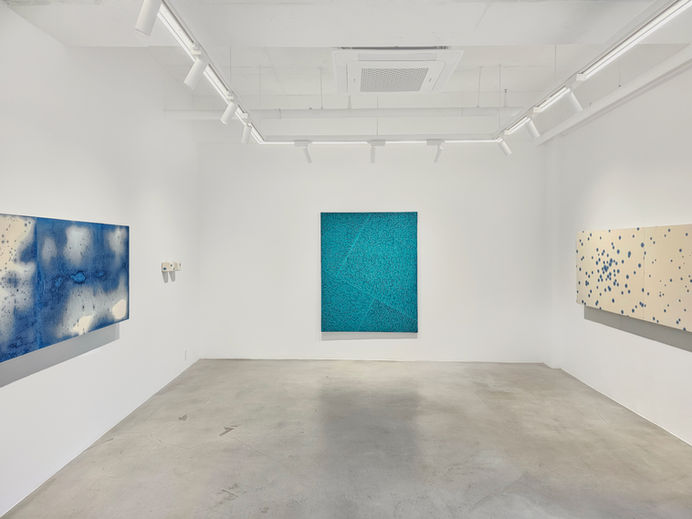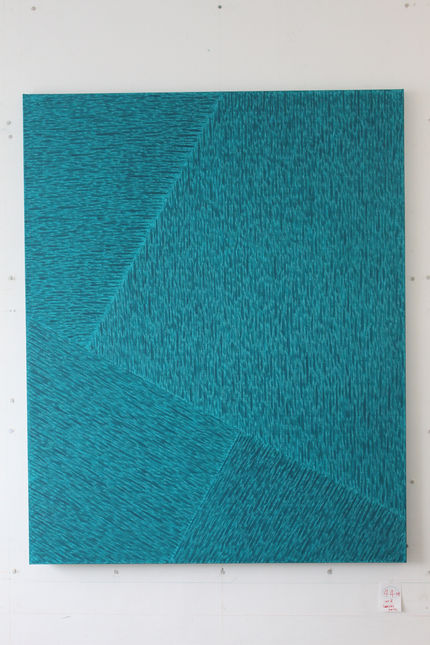아트프로젝트 씨오(대표 임은혜)는 우아하고도 엉뚱한, 아카데믹하면서도 새로운, 다른 듯 닮은 ‘이인현, 박기원’ 2인이 참여하는 《꿈 영혼 아트 말고》를 개최한다. ‘기울어진 일상미학’을 선보이는 전시 명칭 ‘꿈 영혼 아트 말고’는 아이유의 곡명 ‘봄 사랑 벚꽃 말고’ 곡의 라임(Rhyme)을 맞춘 것이다. 아이유의 곡이 봄을 주제로 한 시즌 송이라면, 이번 전시 제목은 상반된 안티테제(Antithesis)를 사용한 본질 너머의 대화에 방점을 찍는다. 이들의 앞선 2인전 《길이와 넓이와 두께에 관한 시간》·《자강두천》·《환상의 멀티버스》에서는 닮은 듯 다른 두 작가의 에너지가 각 기획의 변증법적 대화를 통해 다른 얼굴을 드러냈음을 확인할 수 있었다. 일반 회화론에서 벗어난 이들의 상호작용은 ‘프레임’의 전환을 통해 회화의 조형적 본질에 다가가는 이인현(1958~)의 확장론에서, 회화-설치-오브제의 변신 속에서도 최소의 단위로 환원되는 박기원(1964~)의 본질론에서 확인 가능하다. 서로 간의 매력을 ‘꿈-영혼-아트’가 아닌 ‘무엇(Blank)’으로 열어 놓는 가능성의 테제를 보여주는 것이다. 이번 전시는 회화 안에 펼쳐진 상상의 공간을 ‘노동집약적인 선들’과 ‘무수히 쌓인 레이어(地層)’의 반어법(反語法) 속에서 풀어냄으로써, 관람자들이 새로운 시·공간의 에너지와 만나도록 유도한다.
이인현, 멀티 자아의 위계는 없다.
이인현은 캔버스의 두께를 확장한 <회화의 지층> 시리즈를 선보인다. 다층 면에서 인지되는 캔버스의 여러 얼굴은 평론가 류병학의 표현처럼 ‘정면 회화의 딴지 걸기’라고 할 수 있다. 이인현의 캔버스를 ‘옆면의 승격=경계면의 전복을 통한 승계의 무화(無化)’라고 정의한다면, 캔버스의 모든 면들은 동일한 위계 안에서 평등하다고 할 수 있다. 여기서 진일보한 회화의 재생적 면모는 <회화의 지층 - 환상의 멀티버스> 시리즈를 통해 진일보한다. 다면(多面)을 가진 캔버스는 맑은 물에 비친 달처럼, 원형과 가상을 쌍둥이처럼 연결한 ‘비슷하지만 다른 지층들 간의 합(合)’이다. 왼쪽과 오른쪽/ 혹은 앞과 옆을 번갈아 보는 관객들은 무엇이 먼저고 나중인지를 미묘한 직관과 관찰에 의해서만 알아낼 수 있다. 한 모체에서 분만된 쌍둥이 같은 점(點)들, 의도적으로 농담과 크기의 미세함을 드러낸 제작 의도, 이는 주캐/부캐 사이를 유영하는 21세기 시대정신이 ‘유쾌한 수수께끼’ 속에 담겨 있는 것과 같다. ‘환상의 멀티버스(Amazing Multiverse)’라는 작명 속에도 ‘다중(multi)+우주(universe)’를 유영하는 손오공 같은 다중 주체의 내러티브가 담겨 있는 것이다.
박기원, 넓이(Width)란 상상적 인지의 실체이다.
박기원은 <넓이> 시리즈에서 넓이를 인지하기 위한 선(線)들 사이의 대화를 선보인다. 물질감을 최소화한 회화, 캔버스 위를 떠다니는 오일 스틱의 선들, 하지만 멀리 떨어져 보면 색면(色面) 덩어리로 인지된다. 형태 없는 물질을 인지하는 방법이랄까. 평면 작품에 붙은 ‘넓이’ 뒤에 붙은 44번, 넓이 106번부터 114번까지의 연번들, 무수한 사선들이 담아낸 감각의 연결들은 우리에게 다양한 상상을 불러일으킨다. 클로스 볼(Cloth ball)로 공간 전체를 메웠던 '차(茶) 스튜디오'의 <찬 공기(Cold Air)>와 연동했을 때, 넓이란 무수히 현존하는 상상적 공간이 된다. 실제로 아르코미술관의 《어디로 주름이 지나가는가》(2023)라는 전시에서 작가는 일상적 소재를 활용한 공간과 경험의 인지과정을 화면 속에서 각 요소가 교차/중첩하는 방식을 통해 설명한 바 있다. 작가가 의도하는 것은 ‘늘 거기에 있는, 공기와 같은 당위성’이다. 서로가 서로를 지탱해주는 ‘스며드는 선(線)의 중도(中道)’를 통해 서로가 이기적이지 않은 ‘관계 균형적 에너지’를 선보이는 것이다. 많은 작가들이 박기원 작가를 좋아하는 이유는 본인 스스로 어디에도 스밀 수 있는 ‘공기 같은 균형’을 추구하기 때문이 아닐까. 작가의 넓이 시리즈는 각기 다른 작업임에도 부여된 번호와 관계없이 ‘원래의 바탕이듯’ 그렇게 서로를 오마주 한다. 서로에게 흡수되는 화음의 매력처럼, 마치 교향곡과 같은 상상으로 ‘여백인 듯 자연스럽게’ 작품화되는 것이다.
스미듯 연결된 순수한 가능성의 이야기들
미셸 푸코(Michel Foucault, 1926~1984)는 『지식의 고고학(L'archeologie du savoir)』(1969)에서 모든 담론의 배경이 되는 인식의 지층을 ‘에피스테메(Episteme)’라 칭한다. 하지만 이인현과 박기원의 만남 속에서 이 지층은 시공(時空)을 가로질러 또 다른 가능성의 세계를 형성한다. 어찌 보면 이인현이 지워버린 ‘회화의 위계’는 박기원의 ‘자연 지대’와 만나 더욱 큰 힘을 발휘하며 회화의 결핍을 ‘비규정적 자유언어로’ 치환하는 듯하다. 이는 언제나 새로운 것을 요구하며 발전하려는 목적론적 사유와는 거리가 먼 ‘비계획의 계획=무규정의 가능성’이라고 할 수 있다. 전시는 ‘꿈 영혼 아트’마저 규정해버린 현대사회 속에서 ‘모든 것을 제로 베이스(zero-base)’로 연결한 ‘확장하는 자아’와 만나게 한다. 《꿈 영혼 아트 말고》라는 전시의 라임을 《지층 넓이 아트 말고》로 치환해보면 어떨까. 투 샷(2인전)이 하나의 공감으로 이어지는 재미진 사유의 폭발 속에서 우리들은 세포 분열하듯 새롭게 이어지는 ‘전시개념’의 확장과 만나게 될 것이다.
안현정 (미술평론가, 예술철학박사)
Art Project CO (CEO Eun-Hye Lim) is hosting 《Not Dream, Soul, or Art》, an exhibition featuring the participation of two artists, 'Lee In-Hyeon and Park Ki-Won', whose work is both elegant and quirky, academic yet innovative, different yet similar. The exhibition’s title 'Not Dream, Soul, or Art' is a play on the rhyme of IU’s song 'Not Spring, Love, or Cherry Blossom'. While IU's song is a seasonal track themed around spring, the title of this exhibition employs an opposing antithesis, focusing on a dialogue that goes beyond the essence. In their previous exhibitions, the dialectical dialogue between two seemingly similar but distinct artists revealed different facets of their work. Their interactions deviate from conventional painting theories, as seen in Lee In Hyeon’s (1958~) expansion theory, which approaches the structural essence of painting through a shift in 'frames.' Similarly, Park Ki Won’s (1964~) theory of essence is evident in the transformation of painting-installation-objects, reducing them to their minimal units. What if we replace the rhyme of the exhibition 《Not Dream, Soul, or Art》 with 《Not Layers, Depth, or Art》? In the explosive interplay of ideas where a two-person show connects as one shared understanding, we will encounter the expansion of an 'exhibition concept' that unfolds like cell division, constantly renewing itself.
LEE IN HYEON: There is no hierarchy in the multiple selves.
Lee In Hyeon presents the series <Layers of Painting>, which extends the thickness of the canvas. If we define Lee In Hyeon’s canvas as ‘the promotion of the side = the dissolution of succession through the subversion of the boundary,’ then all surfaces of the canvas can be considered equal within the same hierarchy. The evolved aspect of painting’s regenerative nature advances in the series <Layers of Painting - The Illusory Multiverse>. The identical bar-shaped canvases placed on the floor, like the moon reflected in clear water, represent a 'union of similar but different layers,' linking circles and the virtual like twins. Viewers who alternate between looking from the left and right or from the front and side can only discern what comes first and what comes next through subtle intuition and observation. Points that are like twins born from a single entity, the artist’s intention is to deliberately reveal variations in intensity and subtlety of size reveal the 21st-century zeitgeist, which swims between main and secondary characters, encapsulated in a 'playful enigma.
PARK KI WON: Width is the Embodiment of Imaginative Cognition
In the <Width> series, PARK KI WON presents a dialogue between lines intended to perceive width. The paintings, which minimize material texture and feature lines of oil stick floating on the canvas, appear as color blocks from a distance. This reflects a method of perceiving formless matter. The sequential numbers 44, 106 through 114, attached to the term ‘width’ in the flat works, and the countless diagonal lines evoke a range of imaginations. The artist’s intention is to express a ‘pervasive necessity, like air, that is always there.’ Through the ‘middle path of permeating lines’ that support each other, the work demonstrates a ‘relationally balanced energy’ that is not self-serving. Many believe that PARK KI WON is admired by other artists because he pursues a ‘balanced air’ that can blend into any context.Art Project CO (CEO Eun-Hye Lim) is hosting 《Not Dream, Soul, or Art》, an exhibition featuring the participation of two artists, 'Lee In-Hyeon and Park Ki-Won', whose work is both elegant and quirky, academic yet innovative, different yet similar. The exhibition’s title 'Not Dream, Soul, or Art' is a play on the rhyme of IU’s song 'Not Spring, Love, or Cherry Blossom'. While IU's song is a seasonal track themed around spring, the title of this exhibition employs an opposing antithesis, focusing on a dialogue that goes beyond the essence. In their previous exhibitions, the dialectical dialogue between two seemingly similar but distinct artists revealed different facets of their work. Their interactions deviate from conventional painting theories, as seen in Lee In Hyeon’s (1958~) expansion theory, which approaches the structural essence of painting through a shift in 'frames.' Similarly, Park Ki Won’s (1964~) theory of essence is evident in the transformation of painting-installation-objects, reducing them to their minimal units. What if we replace the rhyme of the exhibition 《Not Dream, Soul, or Art》 with 《Not Layers, Depth, or Art》? In the explosive interplay of ideas where a two-person show connects as one shared understanding, we will encounter the expansion of an 'exhibition concept' that unfolds like cell division, constantly renewing itself.
LEE IN HYEON: There is no hierarchy in the multiple selves.
Lee In Hyeon presents the series <Layers of Painting>, which extends the thickness of the canvas. If we define Lee In Hyeon’s canvas as ‘the promotion of the side = the dissolution of succession through the subversion of the boundary,’ then all surfaces of the canvas can be considered equal within the same hierarchy. The evolved aspect of painting’s regenerative nature advances in the series <Layers of Painting - The Illusory Multiverse>. The identical bar-shaped canvases placed on the floor, like the moon reflected in clear water, represent a 'union of similar but different layers,' linking circles and the virtual like twins. Viewers who alternate between looking from the left and right or from the front and side can only discern what comes first and what comes next through subtle intuition and observation. Points that are like twins born from a single entity, the artist’s intention is to deliberately reveal variations in intensity and subtlety of size reveal the 21st-century zeitgeist, which swims between main and secondary characters, encapsulated in a 'playful enigma.
PARK KI WON: Width is the Embodiment of Imaginative Cognition
In the <Width> series, PARK KI WON presents a dialogue between lines intended to perceive width. The paintings, which minimize material texture and feature lines of oil stick floating on the canvas, appear as color blocks from a distance. This reflects a method of perceiving formless matter. The sequential numbers 44, 106 through 114, attached to the term ‘width’ in the flat works, and the countless diagonal lines evoke a range of imaginations. The artist’s intention is to express a ‘pervasive necessity, like air, that is always there.’ Through the ‘middle path of permeating lines’ that support each other, the work demonstrates a ‘relationally balanced energy’ that is not self-serving. Many believe that PARK KI WON is admired by other artists because he pursues a ‘balanced air’ that can blend into any context.
Ahn Hyun-jung (Art critic/Ph.D. in Art Philosophy)














